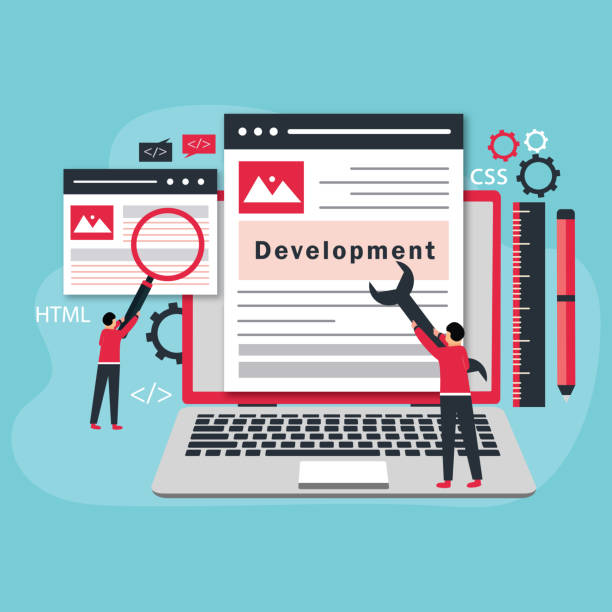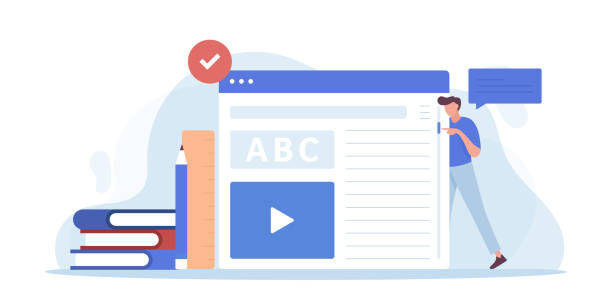Introduction to Online Store Design and Its Importance in the Digital Age
![]()
Today, in a world rapidly moving towards digitalization, having an online store is no longer a luxury choice, but a business necessity.
#OnlineStoreDesign allows businesses to reach a wider audience, eliminate geographical limitations, and offer their services 24 hours a day, seven days a week.
This trend has created a profound transformation in the way goods are bought and sold, challenging traditional markets.
With the widespread use of the internet and smartphones, consumer behavior has also changed, and their inclination towards online shopping has significantly increased.
This paradigm shift in lifestyle and shopping habits highlights the need for a strong and effective online presence more than ever.
The importance of professional online store design is not limited to wider access and the removal of physical boundaries.
A high-quality e-commerce website increases credibility and customer trust, acting like a real-world storefront that must be attractive, organized, and inviting.
Online store design should be such that it provides a smooth and pleasant user experience for visitors; from easy navigation and quick product search to a simple and secure purchasing process.
This not only helps attract new customers but also ensures the loyalty of existing customers, as a positive experience encourages customers to return.
Your website is not just a place to sell products, but also a center for interaction and building relationships with customers.
Furthermore, a suitable online store website provides powerful tools for data analysis and customer behavior.
This data can help you optimize your marketing strategies, better manage inventory, and even introduce new products based on market needs.
Advanced analytical capabilities allow for the identification of purchasing patterns, best-selling products, and unmet customer needs.
In summary, investing in modern and efficient online store design is not just an expense, but a strategic investment for the future and sustainable growth of your business in today’s competitive world.
This investment provides the foundation for a powerful digital presence and the ability to adapt to market changes.
In the rest of this comprehensive article, we will delve deeper into each aspect related to creating and managing a successful online store.
(Descriptive)
Are you tired of your online store website not generating as much revenue as it could? Rasaweb, an expert in professional online store design, solves this problem permanently!
✅ Increase sales and revenue
✅ High load speed and unparalleled user experience
⚡ Get free online store design consultation
Initial Stages of Online Store Design: Comprehensive Planning and Research

Before any practical step for online store design, the planning and research phase is of utmost importance.
This phase forms the foundation of your project’s success and can make the difference between an ordinary online store and a thriving digital business.
#MarketResearch #TargetAudienceDefinition are the first essential steps in this path.
You need to carefully examine who your target market is, what their needs and pain points are, and how your products or services can address these needs.
Detailed understanding of audience demographics, psychographics, and behavior helps you target your content and products correctly.
Competitor analysis is also an integral part of this phase; understanding your competitors’ strengths and weaknesses can help you find a competitive advantage and create a distinct online store website.
This analysis includes examining competitors’ site structure, marketing strategies, pricing, and user experience.
In this phase, you must clearly define your goals.
Is your goal simply to increase sales, or do you want to raise brand awareness, or both? Setting Specific, Measurable, Achievable, Relevant, and Time-bound (SMART) goals helps you have a clear roadmap for designing and developing your online store.
For example, the goal could be a 20% increase in sales in the first six months after launching the site, or acquiring 200 new customers in the first three months.
Also, you need to realistically estimate the project budget and timeline.
A precise financial plan prevents problems and project stoppages midway and optimizes resource allocation.
This includes design, development, hosting, marketing, and maintenance costs.
Furthermore, the selection of product types and their categorization, the site’s content structure, and the key features you want to have on your website should be reviewed in this phase.
Do you need features like product customization, customer review section, rating system, online chat, or integration with social networks? All these details will be effective in the final quality of your online store design and should be chosen based on your audience’s needs and business goals.
Don’t forget that consulting with web design and development specialists in these initial stages can bring valuable insights and prevent costly mistakes.
Comprehensive research and precise planning form the backbone of a successful online store and pave the way for flawless execution.
(Specialized)
Choosing the Right Platform for Online Store Design: Technical and Performance Considerations
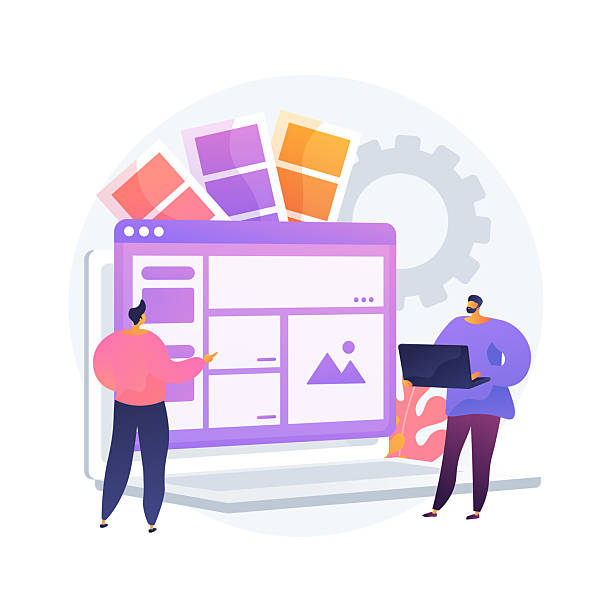
One of the most important decisions in online store design is choosing the right platform.
This choice not only affects initial and maintenance costs but also significantly impacts the site’s capabilities, future expandability, and user experience.
#EcommercePlatform #CMSSelection There are various options available, including open-source Content Management Systems (CMS) like WooCommerce, which operates on WordPress, to cloud-based (SaaS) platforms like Shopify, as well as custom-coded solutions.
Each option has its own architecture, ecosystem, and specific technical requirements.
Each of these options has its own advantages and disadvantages.
WooCommerce is attractive to many small and medium-sized businesses due to its high flexibility, large number of plugins and themes, and relatively lower initial cost.
High customization freedom and full control over data are among its advantages.
However, the responsibility for its maintenance, security, performance optimization, and hosting management lies with you, which requires technical knowledge.
In contrast, Shopify is a comprehensive and managed (SaaS) solution where you don’t need to worry about hosting, security, or updates.
Ease of use and quick setup are its strengths.
But you have less freedom for deep customizations, and its monthly costs (especially with increasing scale and the need for paid plugins) might be high for some businesses.
Magento is also a powerful open-source platform suitable for large and complex stores with specific needs (such as multi-vendor or high transaction volume), but it requires high technical expertise for setup and maintenance, and its development costs are significantly higher.
To help with decision-making, please refer to the table below, which provides a general comparison between three popular platforms:
| Feature | WooCommerce | Shopify | Magento |
|---|---|---|---|
| Platform Type | Open-source (WordPress Plugin) | Cloud-based (SaaS) | Open-source |
| Ease of Use | Medium (requires WordPress and hosting knowledge) | High (suitable for beginners) | Low (requires developer expertise) |
| Initial Cost | Low (only hosting and domain) | Medium (monthly subscription) | High (specialized development and maintenance) |
| Flexibility | High (deeply customizable) | Medium (limited to Shopify themes) | Very High (enterprise solutions) |
| Security and Maintenance | User’s responsibility | Platform’s responsibility | User’s responsibility |
| Suitable For | Small to medium businesses with limited budget and high control | Small to large businesses that need speed and simplicity | Large and complex stores with specific needs and high budget |
Deciding on the right platform for your online store website design should be based on your budget, technical needs, desired level of control, scalability, and long-term plans.
A wrong choice can lead to significant costs in the future.
(Educational)
User Experience (UX) and User Interface (UI) Design in Online Stores: Key to Customer Attraction
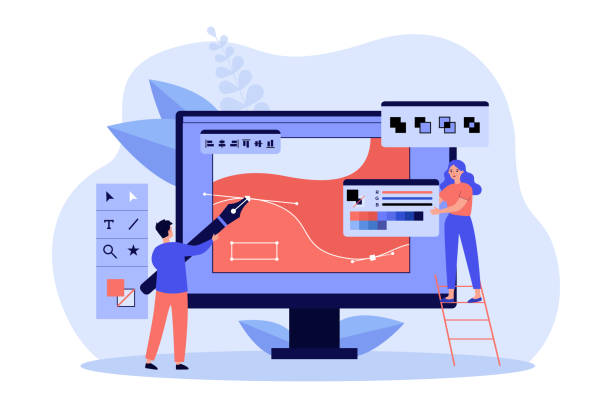
In the highly competitive world of e-commerce, simply having a website is not enough; it is the quality of your website’s User Experience (UX) and User Interface (UI) that determines whether visitors convert into customers.
#UserExperience #UserInterface #UX_UI_Ecommerce These two concepts work hand-in-hand in online store design to provide a pleasant and effective shopping journey for users.
UI relates to the site’s look and feel (colors, fonts, button layout, form design), while UX refers to the entire user experience interacting with the site (ease of navigation, loading speed, logic of the purchase process, satisfaction level).
An attractive user interface design without a smooth user experience is like a beautiful book with incomprehensible content.
A successful UI/UX design in an online store must adhere to several key principles to maximize conversion rates:
- Easy and Intuitive Navigation: Customers should be able to easily find the products they are looking for, navigate between categories, and access different pages of the site.
Clear menus, efficient search bars with advanced filtering capabilities, and a logical page hierarchy are essential.
Every click should bring the user closer to their goal. - High Loading Speed: Today’s users are impatient; even a few seconds of delay can lead to a user abandoning the site.
A slow site can result in lost sales.
Image optimization (compression and use of modern formats), caching, CSS and JavaScript code optimization, and choosing a strong, audience-proximate hosting provider are factors that affect speed. - Responsive Design: Given the increase in purchases via smartphones and tablets, your online store design must be fully compatible with various devices and screen sizes.
This means that the user experience should be as optimized and pleasant on mobile as it is on desktop. - High-Quality Product Images and Descriptions: Customers cannot touch or see the product up close, so high-quality images from different angles, zoom capability, product videos, and comprehensive and accurate product descriptions replace this sense and aid informed decision-making.
- Simple and Secure Payment Process: Complexity at the payment stage is one of the main reasons for shopping cart abandonment.
The payment process should be multi-step, transparent, with minimal friction (such as no mandatory registration), and accompanied by visual confirmation and feedback.
Ensuring the security of payment information is also crucial and must be clearly shown to the user. - Feedback and Support: Providing easy ways to contact support (online chat, phone number, email), displaying customer reviews and ratings, and enabling feedback submission increases trust and confidence and creates a sense of support for the customer.
Finally, remember that the goal of UI/UX design in an online store is not just to look beautiful, but to increase conversion rates and customer loyalty.
A website with a poor user experience, even if it has the best products, will fail to attract and retain customers and will quickly lose its visitors.
(Guidance)
Did you know that 94% of a first impression of a company is related to its website design?
Rasaweb, by providing professional corporate website design services, helps you create the best first impression.
✅ Create a professional and trustworthy image of your brand
✅ Easier attraction of potential customers and improvement of online positioning
⚡ Get free corporate website design consultation
SEO for Online Stores: Optimization for Visibility and Traffic Increase
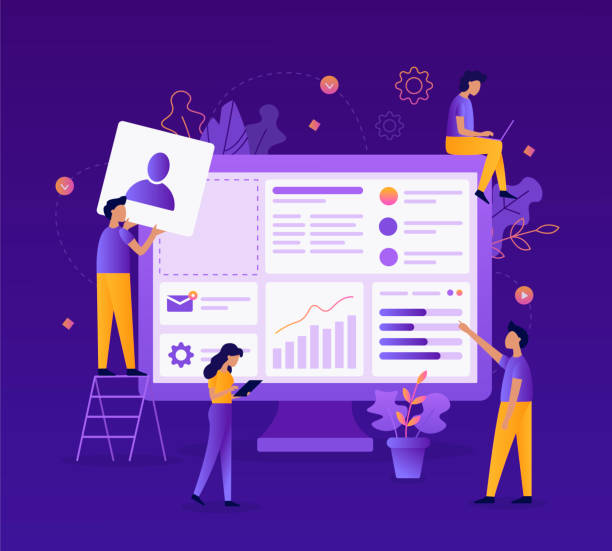
After completing online store design, the next step is to ensure that potential customers can find you.
This is where Search Engine Optimization (SEO) comes into play.
#EcommerceSEO #TrafficIncrease #Keywords SEO is a set of actions that helps your website achieve a higher ranking in Google and other search engine results, thereby attracting more organic (free) traffic.
For an online store, SEO is of vital importance because a large portion of online purchases begin with an internet search, and appearing on the first pages of search results significantly increases the chance of visibility and sales.
SEO principles for an online store website are divided into several categories, each complementing the others:
- Keyword Research: This is the first and most important step.
You need to find the words your customers use to search for your products or services.
These keywords can range from general terms to very specific phrases (Long-Tail Keywords).
These keywords should be naturally and sparingly included in your page titles, product descriptions, meta tags (Meta Titles and Meta Descriptions), and site content. - Content Optimization (On-Page SEO): Each product and category page should have unique, comprehensive descriptions containing relevant keywords.
Use high-quality, web-optimized images (with low file size and appropriate Alt tags).
Writing relevant blogs, buying guides, and valuable content also helps increase site authority and ranking. - Technical SEO: Ensuring that your website is technically accessible and indexable for search engine crawlers.
This includes site loading speed, responsiveness (mobile compatibility), friendly URL structure (readable URLs), use of an XML Sitemap, and a suitable robots.txt file.
Managing 404 errors and 301 redirects is also important. - Internal Linking Structure: Creating a logical and hierarchical internal link structure that helps search engines discover different pages of your site and understand their value.
Linking to product pages from blog or category pages are examples of this approach. - Backlinking (Off-Page SEO): Attracting links to your site from other reputable websites.
This can be done through producing valuable content that other sites link to, digital public relations, collaborations with influencers, and presence in authoritative directories.
Backlinks show search engines that your site is a credible and reliable source. - Use of Structured Data (Schema Markup): Adding schema codes to product pages, customer reviews, prices, and inventory information so that search engines can display more precise information about your content in search results (such as star ratings, price, and availability in search results).
SEO is an ongoing process and requires continuous monitoring, analysis, and regular updates.
Google’s algorithms are constantly changing, so to maintain and improve your ranking, you must continuously work on optimizing your online store.
The ultimate goal is to increase site visibility and attract targeted traffic, which will ultimately lead to increased sales and the success of your e-commerce website.
(Educational)
Security and Payment Gateways in Online Store Design: The Most Vital Aspects
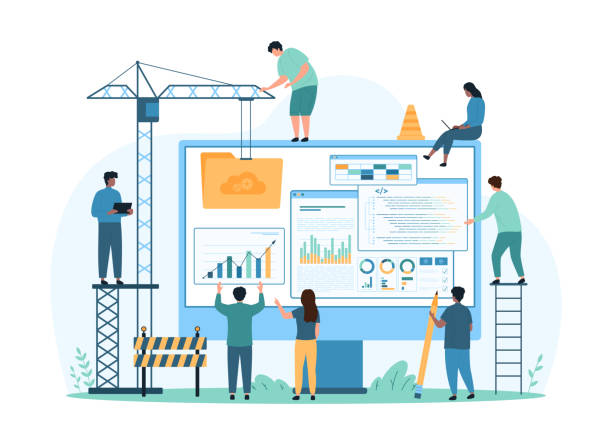
One of the main concerns for customers when shopping online is the security of their personal and financial information.
Therefore, in online store design, ensuring security should not be an option, but an absolute priority.
#OnlineStoreSecurity #PaymentGateway #SSLCertificate Neglecting this issue can lead to loss of customer trust, serious damage to brand reputation, and even severe legal consequences.
A security incident can destroy years of brand-building efforts.
The most important security aspects to consider in the design and maintenance of an online store website are:
- SSL Certificate (Secure Sockets Layer): This certificate creates a security layer that encrypts communication between the website and the user’s browser.
The presence of a green lock icon next to the site address (HTTPS) assures customers that their information, such as credit card details or personal data, is secure and cannot be intercepted by unauthorized individuals.
This is a fundamental standard for any online site. - Secure Payment Gateways: Using reputable and recognized payment gateways with high security protocols is essential.
These gateways are responsible for processing bank card information and must comply with Payment Card Industry Data Security Standards (PCI DSS).
Ensure that your chosen gateway supports security features like 3D Secure or dynamic second password to provide an additional layer of protection against fraud. - Protection Against Cyberattacks: Implementing Web Application Firewalls (WAF) to filter malicious traffic, Intrusion Detection Systems (IDS) to identify suspicious activities, and regularly updating the core system, plugins, and themes to prevent malware attacks, SQL injection, and XSS (Cross-Site Scripting) are vital measures.
Also, using strong passwords and two-factor authentication for the site’s admin panel is crucial. - Privacy Policy: Having a clear and transparent privacy policy that explains how customer information is collected, stored, and used, and gives them choices.
This helps increase customer trust and shows that you respect their rights. - Regular Backups: Performing regular and automated backups of the entire website and database in a secure, separate location, for quick recovery in case of any issues, hardware failure, or cyberattack.
These backups should be regularly tested to ensure their integrity.
Payment gateways also play a vital role in completing the purchase process and must function flawlessly.
In Iran, direct bank payment gateways or intermediary PSP (Payment Service Provider) companies like ZarinPal, IDPay, etc., are commonly used.
When choosing a payment gateway for your online store, pay attention to the following factors:
- Transaction fees and their transparency
- Ease of integration with your site platform and available technical documentation
- Settlement speed and deposit of funds into your account
- Support for various card types and payment methods (e.g., Shaparak cards, e-wallets)
- Credibility, track record, and technical support of the gateway provider company
A secure online store design that uses reliable payment gateways not only protects your customers’ information but also builds credibility for your brand and creates a more enjoyable and worry-free shopping experience for users, which directly impacts conversion rates and customer loyalty.
(Specialized)
Marketing and Advertising After Launching an Online Store: Growth Strategies

After successfully designing and launching your online store, your work has just begun.
A great website alone won’t attract customers; you need a comprehensive marketing and advertising strategy to guide potential customers to your online store and convert them into buyers.
#DigitalMarketing #OnlineAdvertising #OnlineStoreStrategy The main goal is to increase targeted traffic, build brand awareness, and ultimately convert visitors into loyal customers.
This process requires a multi-channel and continuous approach.
There are several digital marketing channels you can leverage to promote your online store.
The right choice and combination of these channels depend on your product type, target audience, and marketing budget:
- Content Marketing: Producing valuable, useful, and engaging content such as blog articles, buying guides, infographics, educational videos, and podcasts that answer customer questions, address their needs, and assist them in their purchase journey.
This content not only helps your site’s SEO but also establishes your brand as a credible authority in your industry and builds long-term customer relationships. - Social Media Marketing: Active and targeted presence on platforms like Instagram, Telegram, Facebook, LinkedIn, and Pinterest (depending on your audience).
Sharing attractive product images and videos, running interactive contests and campaigns, responding to comments and messages, and executing paid advertising campaigns are among the effective activities in this area.
Social media platforms are powerful tools for increasing brand awareness and building a community of loyal customers. - Email Marketing: Collecting visitors’ and customers’ email addresses (with their permission) and sending newsletters, special offers, new product information, abandoned cart reminders, and exclusive content.
This method is one of the most effective marketing channels, allowing for direct and personalized communication with customers, and has a high return on investment (ROI). - Pay-Per-Click (PPC) Advertising: Using platforms like Google Ads (for display in search results and display networks) and social media advertising (Facebook Ads, Instagram Ads) to display targeted ads to specific audiences based on their interests, behavior, and demographics.
This method can yield faster results and quickly generate traffic and sales. - Influencer Marketing: Collaborating with individuals who have significant influence and a large audience in your field of activity to promote and advertise your products.
This method can quickly build trust and introduce your products to the influencer’s new and loyal audience. - Affiliate Marketing: Collaborating with other individuals or websites who receive a commission for each sale or customer acquisition through their unique links.
Choosing the best marketing strategies for your online store website depends on your product type, target audience, and budget.
In many cases, a smart combination of these strategies will yield the best results and can turn your investment in creating an online store into profitability.
Continuous monitoring and optimization of campaigns based on data are essential for success.
(Analytical)
Maintaining and Updating an Online Store Website for Sustainable Success
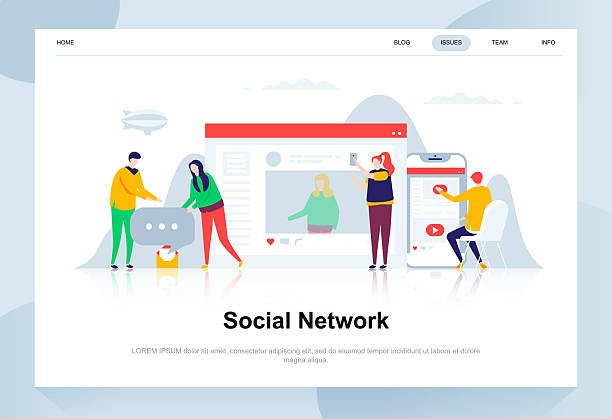
Online store design and launch is only half the battle.
To ensure optimal performance, stable security, and long-term success, regular website maintenance and updates are essential.
#OnlineStoreMaintenance #WebsiteUpdates #SitePerformance Neglecting this stage can lead to serious security issues, reduced site speed, poor user experience, data loss, and ultimately loss of customers and revenue.
An online store, like a physical shop, requires continuous care and tidiness to remain attractive and efficient.
Key activities in e-commerce website maintenance and updates include:
- Software Updates: The core platform of the site (such as WordPress/WooCommerce, Magento), all plugins, and themes used must be regularly updated as soon as new versions are released.
These updates include security patches to fix vulnerabilities, performance improvements, bug fixes, and new feature additions.
Delaying this can leave your site vulnerable to attacks. - Security Monitoring: Continuous monitoring to identify and fix any security vulnerabilities, monitoring suspicious logins and unauthorized activities, and performing regular security scans to ensure the absence of malware and viruses.
The use of web application firewalls and intrusion detection systems is also recommended. - Website Performance and Speed Monitoring: Using tools like Google PageSpeed Insights or GTmetrix to evaluate site loading speed and perform necessary optimizations such as image compression, HTML/CSS/JS code optimization, and using a CDN (Content Delivery Network) to reduce loading times.
Site speed directly affects user experience and SEO. - Inventory and Product Management: Regularly updating product information, prices, discounts, stock status, and adding new products in a timely manner.
Removing out-of-stock or old products, updating product descriptions and images are also important for maintaining site order and attractiveness. - Customer Support: Prompt and effective response to customer questions, comments, and issues through various channels such as online chat, email, or phone.
A strong support system helps increase customer satisfaction and loyalty and provides valuable feedback for site improvement. - Regular Backup: Performing regular and automated backups of the entire website (files) and database in a secure location separate from the main server.
This is essential for quick data recovery in case of any system failure, cyberattack, or human error.
These backups should be periodically tested to ensure their integrity. - Data Analysis and Reporting: Regularly reviewing site statistics (traffic, conversion rates, bounce rate, user navigation paths) using tools like Google Analytics.
These analyses help you identify your site’s strengths and weaknesses and adopt better strategies for improving your online store, such as optimizing product pages or enhancing the payment process.
Active and continuous maintenance not only contributes to the site’s stable performance but also ensures continuous improvement of the user experience and leads to sustained sales growth.
An online store that is regularly updated is always more attractive to customers, more reliable for search engines, and more resilient to security threats.
(Descriptive)
Did you know that a poor corporate website daily takes away many opportunities from you? Solve this problem permanently with professional corporate website design by Rasaweb!
✅ Create a powerful and trustworthy image of your brand
✅ Targeted attraction of new customers and increased sales
⚡ [Get Free Website Design Consultation]
Challenges and Solutions in Online Store Design and Management: Overcoming Obstacles
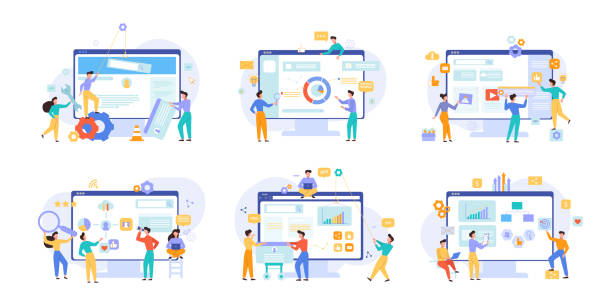
Although online store design has high potential for growth and success, its path is not without challenges.
Recognizing these obstacles and being prepared to confront them is key to success in managing an online store.
#OnlineStoreChallenges #EcommerceSolutions #OnlineStoreManagement Many businesses initially enter this field with enthusiasm, but facing problems, they become disheartened and may cease to continue.
The intriguing content is how these challenges can be turned into opportunities and leveraged to strengthen the business’s position?
Some of the most common challenges and practical solutions for them include:
- Intense Competition: With the increasing number of online stores in every field, competition also intensifies, and differentiation becomes more difficult.
- Solution: Creating a unique competitive advantage (USP), which can include offering specific products, excellent customer service, competitive pricing, or focusing on a specific niche market.
Also, continuous improvement of the shopping experience and fostering loyalty among existing customers are very important.
- Solution: Creating a unique competitive advantage (USP), which can include offering specific products, excellent customer service, competitive pricing, or focusing on a specific niche market.
- Low Traffic Attraction and Conversion Rates: Many sites have low traffic or their visitors do not convert into customers, indicating inefficiency in attraction or persuasion.
- Solution: Smart investment in SEO to attract organic traffic, executing targeted advertising campaigns (PPC) on Google and social media, content marketing to build credibility and generate leads, and continuous optimization of user experience (UX) to improve conversion rates (A/B testing pages, simplifying forms and the payment process).
- Inventory and Logistics Management: Precise inventory control, order processing, packaging, and timely product shipping can become complex and time-consuming, especially with increased sales volume.
- Solution: Using Inventory Management Systems (IMS) and Order Management Systems (OMS), collaborating with reputable and reliable logistics companies, and automating warehousing and shipping processes as much as possible.
Also, offering various shipping options to customers (e.g., express or economy shipping) can be satisfactory.
- Solution: Using Inventory Management Systems (IMS) and Order Management Systems (OMS), collaborating with reputable and reliable logistics companies, and automating warehousing and shipping processes as much as possible.
- Customer Support and Satisfaction: Customer dissatisfaction due to inadequate response or post-purchase issues can quickly damage brand reputation and lead to customer loss.
- Solution: Creating multiple and accessible communication channels (online chat, phone, email, WhatsApp), training staff for quick, polite, and effective responses, effectively resolving issues, and regularly collecting customer feedback to improve services.
- Cybersecurity and Fraud: The risk of cyberattacks (such as DDoS, SQL Injection) and fraudulent transactions always exists in e-commerce.
- Solution: Regularly updating systems, using a valid SSL certificate, implementing web application firewalls, using secure and reputable payment gateways with fraud detection capabilities, and educating employees on security protocols.
- Regulations and Legal Issues: Laws related to e-commerce, data privacy (such as GDPR internationally), and taxation can be complex and change.
- Solution: Consulting with legal experts and ensuring full compliance with relevant regulations in your field of activity.
Transparency regarding terms and conditions, return policy, and privacy is essential.
- Solution: Consulting with legal experts and ensuring full compliance with relevant regulations in your field of activity.
Each of these challenges can be an opportunity for learning, improvement, and innovation.
An active and analytical management alongside a flexible online store design that can adapt to changes can put your business on the path to sustainable growth and success in the competitive e-commerce market.
(Analytical)
The Future of Online Store Design and New Trends: Exciting Developments
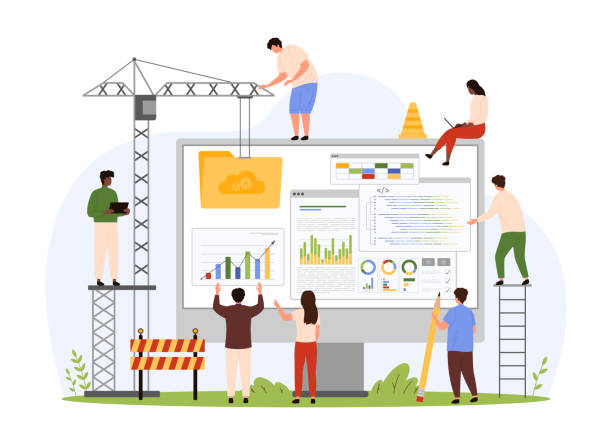
The world of e-commerce is rapidly evolving, and online store design is no exception.
To succeed in the future, businesses must be aware of new trends and adapt to them to remain competitive and meet the changing needs of consumers.
#FutureOfOnlineStore #EcommerceTrends #EcommerceTechnology This section examines some of the most exciting developments and outlooks in this industry that will not only revolutionize the shopping experience but also provide new opportunities for customer interaction.
Key trends shaping the future of online store design include:
- Artificial Intelligence (AI) and Machine Learning:
- Advanced Personalization: Using AI to analyze customer behavior in real-time and provide highly personalized product recommendations, targeted discounts, custom content, and a completely unique shopping experience for each user.
This can significantly increase conversion rates and customer loyalty. - AI-Powered Chatbots and Virtual Assistants: AI-powered chatbots will be able to provide 24/7 customer support, answer complex questions, guide the purchase process, and even suggest suitable products based on conversations.
- Dynamic Pricing Optimization: AI can dynamically suggest optimal prices by analyzing market data, competitor behavior, inventory, and demand.
- Search Optimization: AI algorithms can significantly improve internal site search results.
- Advanced Personalization: Using AI to analyze customer behavior in real-time and provide highly personalized product recommendations, targeted discounts, custom content, and a completely unique shopping experience for each user.
- Augmented Reality (AR) and Virtual Reality (VR):
- AR allows customers to view products in their real-world environment, for example, virtually trying on clothes on their body, or seeing furniture arrangement in their home before purchase.
This technology reduces online shopping ambiguity and gives the customer more confidence. - VR can simulate a virtual store shopping experience, allowing customers to explore products in a 3D environment.
- AR allows customers to view products in their real-world environment, for example, virtually trying on clothes on their body, or seeing furniture arrangement in their home before purchase.
- Voice Search and Voice Commerce: With the increasing use of voice assistants like Siri, Alexa, and Google Assistant, optimizing the site for voice search (Voice SEO) is becoming increasingly important.
This includes using conversational keywords and direct answers to questions.
The ability to purchase products with just voice commands will also soon become widespread. - Social Commerce: The ability to directly purchase products through social media platforms like Instagram, TikTok, and Facebook, without needing to leave the application.
This trend blurs the lines between content, entertainment, and shopping, making the purchase process much simpler for the user. - Sustainability and Social Responsibility: Consumers are increasingly interested in brands that value environmental issues, sustainability, and social responsibility.
Online store design that reflects these values, such as showcasing sustainable product sources, eco-friendly packaging options, or transparent supply chain information, can create a competitive advantage. - Headless Commerce: Separating the front-end layer (user interface) from the back-end layer (content management system, database, and business logic) for greater flexibility and providing a seamless user experience across various channels (web, mobile, native apps, IoT devices).
This architecture allows businesses to adapt quickly to new trends.
Keeping pace with these new trends and integrating them into your online store platform can not only improve the shopping experience for customers but also help you lead in the competitive market and gain a larger market share.
The future of online store design and development depends on innovation, anticipating future consumer needs, and optimally utilizing emerging technologies.
(Informative)
Frequently Asked Questions
| Question | Answer |
|---|---|
| What is online store design? | It is the process of building and developing a website for buying and selling products or services online. |
| What features should an online store website have? | Product management, shopping cart, online payment gateway, user account section, product search and filter capability. |
| What is the importance of User Experience (UX) in online store design? | A good user experience leads to easy navigation, a simple purchase process, and ultimately increased customer satisfaction and conversion rates. |
| Why is SEO important for an online store website? | SEO helps your site achieve a higher ranking in search engine results and attract more traffic, which leads to more sales. |
| What platforms are available for online store design? | Ready-made platforms like WordPress (with WooCommerce), Shopify, PrestaShop, and also the possibility of custom design exist. |
And other services of Rasaweb Advertising Agency in the field of advertising
Smart Direct Marketing: Revolutionize user interaction with SEO-driven content strategy.
Smart Data Analysis: An innovative platform to improve customer acquisition using real data.
Smart Sales Automation: An effective tool for online growth by customizing user experience.
Smart Direct Marketing: A specialized service for campaign management growth based on intelligent data analysis.
Smart Custom Software: An innovative platform to improve customer acquisition by managing Google Ads.
And more than hundreds of other services in the field of internet advertising, advertising consultation, and organizational solutions
Internet Advertising | Advertising Strategy | Advertorial
Resources
Online Store Design Guide
Online Store Design
Online Store Website
Website Design Services
? To boost your business in the digital world, Rasaweb Afarin Digital Marketing Agency, with years of experience in providing services such as online store design, SEO, and online advertising, paves your path to success.
📍 Tehran, Mirdamad Street, next to Bank Markazi, Kazerun South Alley, Ramin Alley, No. 6

